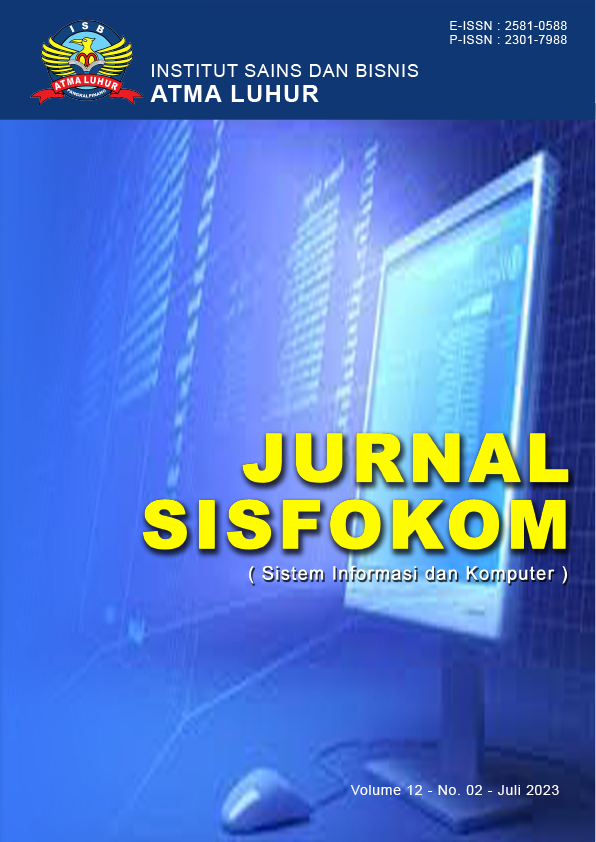Object Recognition with SSD MobileNet Pre-Trained Model in the Cashier Application
DOI:
https://doi.org/10.32736/sisfokom.v12i2.1659Keywords:
Object detection, MobileNet, TensorflowAbstract
Object recognition is a type of image processing technique that is frequently employed in current applications such as facial identification, vehicle detection, and automated cashiers. One issue with barcode and RFID cashier apps is that they cannot scan several products at the same time. The cashier application employing object identification using picture images is believed to be able to distinguish more than one object in order to speed up the transaction process. The usage of SSD pre-trained models with MobileNet architecture to detect items in automatic cashier applications is discussed in this paper. This study put the model to the test on three types of soft drink objects: coca-cola, floridina, and good day. A smartphone camera was used to collect the data, which totaled 203 images. The findings indicated that the product object identification method was 82.9% accurate, 97.5% precise, and 84.7% recall. The object recognition process takes between 365 and 827 milliseconds, with an average time of 695 milliseconds (0.69 seconds).References
A. Ðordevic, Y. Klochkov, S. Arsovski, N. Stefanovic, L. Shamina, and A. Pavlovic, “The impact of ict support and the efqm criteria on sustainable business excellence in higher education institutions,” Sustainability (Switzerland), vol. 13, no. 14, Jul. 2021, doi: 10.3390/su13147523.
A. Qosasi, E. Maulina, M. Purnomo, A. Muftiadi, E. Permana, and F. Febrian, “The impact of Information and Communication Technology capability on the competitive advantage of small businesses,” International Journal of Technology, vol. 10, no. 1, pp. 167–177, 2019, doi: 10.14716/ijtech.v10i1.2332.
T. Gajewska, D. Zimon, G. Kaczor, and P. Madzík, “The impact of the level of customer satisfaction on the quality of e-commerce services,” International Journal of Productivity and Performance Management, vol. 69, no. 4, pp. 666–684, Apr. 2020, doi: 10.1108/IJPPM-01-2019-0018.
J. Davies and Y. Wang, “Physically Unclonable Functions (PUFs): A New Frontier in Supply Chain Product and Asset Tracking,” IEEE Engineering Management Review, vol. 49, no. 2, pp. 116–125, Apr. 2021, doi: 10.1109/EMR.2021.3069366.
X. Zhu, M. Liu, Y. Zhao, L. Dong, M. Hui, and L. Kong, “Product detection based on CNN and transfer learning,” SPIE-Intl Soc Optical Eng, Sep. 2019, p. 69. doi: 10.1117/12.2526236.
M. Haseeb, H. I. Hussain, B. Ślusarczyk, and K. Jermsittiparsert, “Industry 4.0: A solution towards technology challenges of sustainable business performance,” Soc Sci, vol. 8, no. 5, May 2019, doi: 10.3390/socsci8050154.
N. Fitrianingsih Hasan et al., “Deteksi dan Klasifikasi Penyakit Pada Daun Kopi Menggunakan Yolov7,” Sistem Informasi dan Komputer), vol. 12, pp. 30–35, doi: 10.32736/sisfokom.v12i1.1545.
M. Akbar, A. S. Purnomo, and S. Supatman, “Multi-Scale Convolutional Networks untuk Pengenalan Rambu Lalu Lintas di Indonesia,” Jurnal Sisfokom (Sistem Informasi dan Komputer), vol. 11, no. 3, pp. 310–315, Dec. 2022, doi: 10.32736/sisfokom.v11i3.1452.
R. Sujatha, J. M. Chatterjee, N. Z. Jhanjhi, and S. N. Brohi, “Performance of deep learning vs machine learning in plant leaf disease detection,” Microprocess Microsyst, vol. 80, Feb. 2021, doi: 10.1016/j.micpro.2020.103615.
D. Bhatt et al., “Cnn variants for computer vision: History, architecture, application, challenges and future scope,” Electronics (Switzerland), vol. 10, no. 20. MDPI, Oct. 01, 2021. doi: 10.3390/electronics10202470.
F. A. Breve, “COVID-19 detection on Chest X-ray images: A comparison of CNN architectures and ensembles[Formula presented],” Expert Syst Appl, vol. 204, Oct. 2022, doi: 10.1016/j.eswa.2022.117549.
J. Huang et al., “BM-Net: CNN-Based MobileNet-V3 and Bilinear Structure for Breast Cancer Detection in Whole Slide Images,” Bioengineering, vol. 9, no. 6, Jun. 2022, doi: 10.3390/bioengineering9060261.
B. B. M. Wantania, S. R. U. A. Sompie, and F. D. Kambey, “Penerapan Pendeteksian Manusia Dan Objek Dalam Keranjang Belanja Pada Antrian Di Kasir,” Jurnal Teknik Informatika, vol. 15, no. 2, pp. 101–108, Jul. 2020, doi: 10.35793/JTI.15.2.2020.29004.
P. R. Aningtiyas, A. Sumin, and S. Wirawan, “Pembuatan Aplikasi Deteksi Objek Menggunakan TensorFlow Object Detection API dengan Memanfaatkan SSD MobileNet V2 Sebagai Model Pra - Terlatih: Array,” Jurnal Ilmiah Komputasi, vol. 19, no. 3, pp. 421–430, Sep. 2020, doi: 10.32409/JIKSTIK.19.3.68.
S. Srivastava, A. Gangwar, R. Mishra, and S. Singh, “Sign Language Recognition System Using TensorFlow Object Detection API,” in Communications in Computer and Information Science, Springer Science and Business Media Deutschland GmbH, 2022, pp. 634–646. doi: 10.1007/978-3-030-96040-7_48.
Downloads
Additional Files
Published
Issue
Section
License
The copyright of the article that accepted for publication shall be assigned to Jurnal Sisfokom (Sistem Informasi dan Komputer) and LPPM ISB Atma Luhur as the publisher of the journal. Copyright includes the right to reproduce and deliver the article in all form and media, including reprints, photographs, microfilms, and any other similar reproductions, as well as translations.
Jurnal Sisfokom (Sistem Informasi dan Komputer), LPPM ISB Atma Luhur, and the Editors make every effort to ensure that no wrong or misleading data, opinions or statements be published in the journal. In any way, the contents of the articles and advertisements published in Jurnal Sisfokom (Sistem Informasi dan Komputer) are the sole and exclusive responsibility of their respective authors.
Jurnal Sisfokom (Sistem Informasi dan Komputer) has full publishing rights to the published articles. Authors are allowed to distribute articles that have been published by sharing the link or DOI of the article. Authors are allowed to use their articles for legal purposes deemed necessary without the written permission of the journal with the initial publication notification from the Jurnal Sisfokom (Sistem Informasi dan Komputer).
The Copyright Transfer Form can be downloaded [Copyright Transfer Form Jurnal Sisfokom (Sistem Informasi dan Komputer).
This agreement is to be signed by at least one of the authors who have obtained the assent of the co-author(s). After submission of this agreement signed by the corresponding author, changes of authorship or in the order of the authors listed will not be accepted. The copyright form should be signed originally, and send it to the Editorial in the form of scanned document to sisfokom@atmaluhur.ac.id.









